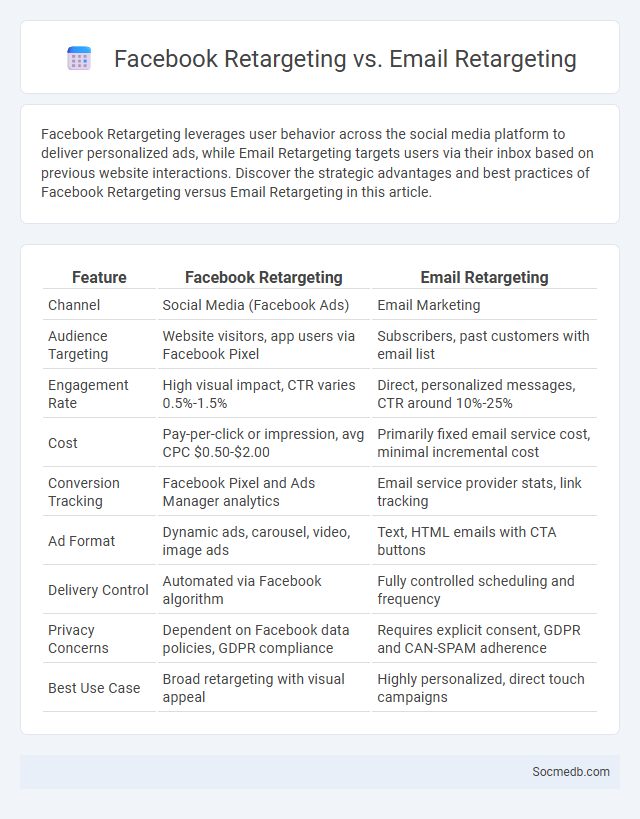
Photo illustration: Facebook Retargeting vs Email Retargeting
Facebook Retargeting leverages user behavior across the social media platform to deliver personalized ads, while Email Retargeting targets users via their inbox based on previous website interactions. Discover the strategic advantages and best practices of Facebook Retargeting versus Email Retargeting in this article.
Table of Comparison
| Feature | Facebook Retargeting | Email Retargeting |
|---|---|---|
| Channel | Social Media (Facebook Ads) | Email Marketing |
| Audience Targeting | Website visitors, app users via Facebook Pixel | Subscribers, past customers with email list |
| Engagement Rate | High visual impact, CTR varies 0.5%-1.5% | Direct, personalized messages, CTR around 10%-25% |
| Cost | Pay-per-click or impression, avg CPC $0.50-$2.00 | Primarily fixed email service cost, minimal incremental cost |
| Conversion Tracking | Facebook Pixel and Ads Manager analytics | Email service provider stats, link tracking |
| Ad Format | Dynamic ads, carousel, video, image ads | Text, HTML emails with CTA buttons |
| Delivery Control | Automated via Facebook algorithm | Fully controlled scheduling and frequency |
| Privacy Concerns | Dependent on Facebook data policies, GDPR compliance | Requires explicit consent, GDPR and CAN-SPAM adherence |
| Best Use Case | Broad retargeting with visual appeal | Highly personalized, direct touch campaigns |
Introduction to Retargeting: Definition and Importance
Retargeting is a powerful digital marketing strategy that targets users who have previously interacted with a brand but did not convert. By showing customized ads to these potential customers on social media platforms like Facebook, Instagram, and LinkedIn, businesses increase conversion rates and improve return on ad spend (ROAS). Effective retargeting leverages data-driven insights and behavioral tracking to re-engage audiences and drive sales growth.
Understanding Facebook Retargeting: How It Works
Facebook retargeting targets users who have previously interacted with your website or content, using custom audiences to display tailored ads that increase conversion rates. By tracking user behavior through the Facebook Pixel, you can segment your audience based on specific actions, such as product views or cart abandonment. You can maximize your ad spend efficiency by reconnecting with warm leads who have demonstrated interest but haven't completed a purchase.
Exploring Email Retargeting: Process and Benefits
Email retargeting involves sending personalized email campaigns to users who have previously interacted with your website or social media content, enhancing conversion rates through targeted messaging. By leveraging user behavior data such as browsing history and abandoned carts, you can deliver relevant offers that increase engagement and drive sales. This strategy maximizes your marketing ROI by reconnecting with potential customers who are already familiar with your brand.
General Retargeting: An Overview
General retargeting in social media leverages cookies and pixel tracking to re-engage users who have previously interacted with a brand's website or app, increasing conversion rates by delivering personalized ads based on prior behavior. Platforms like Facebook, Instagram, and LinkedIn utilize dynamic retargeting to show tailored product recommendations, driving higher click-through rates and ROI. Effective retargeting campaigns rely on segmented audience lists, frequency capping, and timely ad delivery to minimize ad fatigue while maximizing engagement and sales.
Key Differences: Facebook vs Email Retargeting
Facebook retargeting leverages user behavior and demographics within the platform to deliver personalized ads based on interaction with Facebook pages or posts. Email retargeting utilizes a subscriber's previous email engagement and browsing history to send targeted messages, encouraging conversion through personalized content. Facebook retargeting offers broad audience reach and visual ad formats, while email retargeting provides direct communication with high personalization and measurable click-through rates.
Audience Targeting Capabilities Comparison
Social media platforms offer distinct audience targeting capabilities tailored to diverse marketing needs, with Facebook providing detailed demographic filters and interest-based targeting, while LinkedIn excels in professional and B2B segmentation based on job titles and industries. Twitter allows for keyword and follower-based targeting, ideal for real-time engagement and trend-focused campaigns, whereas Instagram leverages visual content to target younger demographics through behavior and location data. To maximize your campaign effectiveness, understanding each platform's unique targeting options ensures precise reach and improved ROI.
Cost Efficiency and ROI Analysis
Social media marketing delivers high cost efficiency by enabling targeted advertising that maximizes budget utilization and reduces wasteful spending. Precise ROI analysis tools allow you to track conversions, engagement rates, and customer acquisition costs, ensuring every dollar invested translates into measurable business growth. Leveraging these insights helps optimize campaigns, improve audience segmentation, and increase overall return on investment.
Ad Formats and Engagement Levels
Social media platforms offer diverse ad formats such as image ads, video ads, carousel ads, and story ads, each designed to capture user attention uniquely and drive higher engagement. Engagement levels vary based on ad creativity, targeting precision, and user interaction features like likes, shares, comments, and click-through rates. To maximize your campaign's impact, selecting the right ad format aligned with your audience's preferences boosts visibility and fosters meaningful connections.
Measuring Success: Analytics and Performance Metrics
Tracking key performance indicators (KPIs) such as engagement rate, reach, and conversion rate helps you measure the success of your social media campaigns. Analytics tools like Google Analytics, Facebook Insights, and Instagram Analytics provide in-depth data on audience behavior and content effectiveness. Consistently monitoring these performance metrics enables informed decisions to optimize content strategy and maximize ROI.
Choosing the Right Retargeting Strategy for Your Business
Selecting the optimal retargeting strategy for your business hinges on understanding customer behavior and segmenting audiences based on engagement levels. Utilizing dynamic ads tailored to previous interactions improves conversion rates by delivering personalized content across platforms such as Facebook, Instagram, and Google Ads. Incorporating frequency caps and excluding recent purchasers ensures budget efficiency and maximizes return on ad spend in social media campaigns.
 socmedb.com
socmedb.com